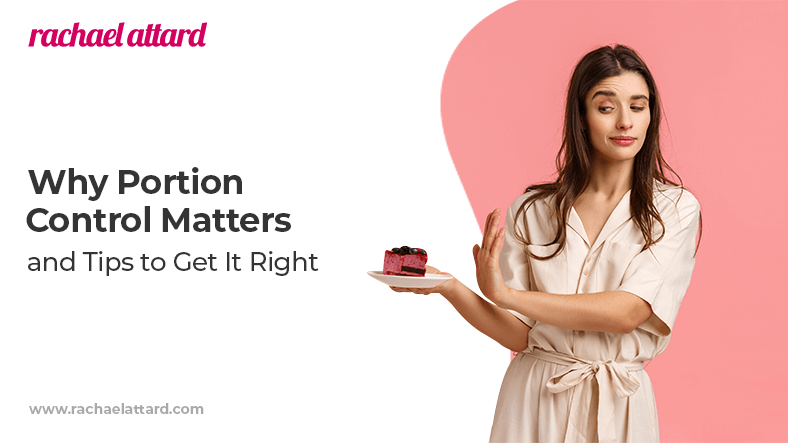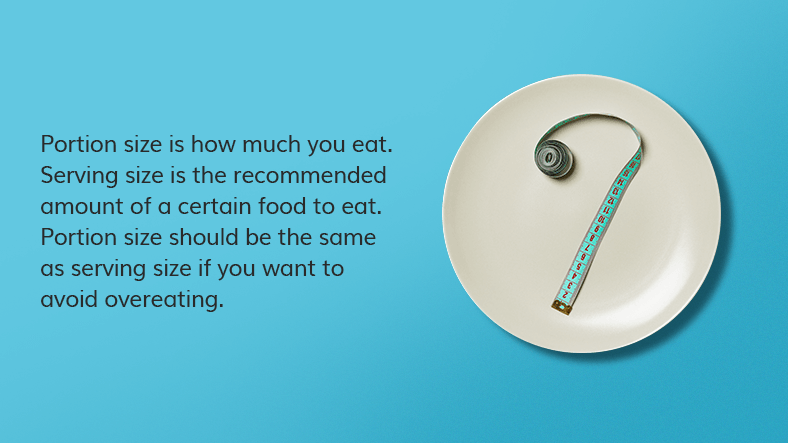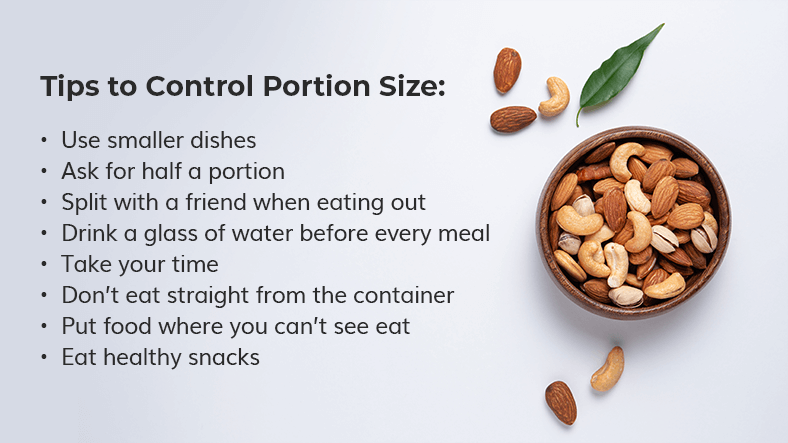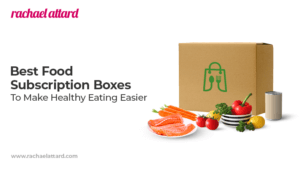Why Portion Control Matters and Tips to Get It Right

I write a lot about the importance of eating well to lose weight, maintain a healthy weight, and feel your best. I’ve struggled with my gut and hormones in the past, and figuring out my diet has been really helpful.
There are a lot of different factors that go into eating well. Vegetables, fruits, sugar content, lean proteins, micronutrients, healthy fats, and so on are some of the things to be thinking about if you want to eat well. But how much you eat also matters.
If you want to have a slim, lean body, you should be mindful of what you’re eating and how much you’re eating. Eating too much food, even food that’s great for your body, can still lead to weight gain. That’s why portion control is so important! :)
Serving Size vs. Portion Size
Portion size is how much food you eat. Serving size is the recommended amount of a certain food to eat (often found on a food item’s nutrition label) or a standard amount of food (like one cup or one item). Your portions might be more than or less than the recommended serving size.
Many people eat more than the recommended amount. In other words, their portion size is larger than the serving size. In fact, adults eat about 300 calories more per day than they did in 1985, and the reason comes down to portion sizes.
Your portions might change from meal to meal too. For example, when you eat at home, you might limit yourself to one piece of bread for dinner. At a restaurant, you might catch yourself eating multiple pieces.
You might be overeating without realizing it for a few reasons:
- You don’t know what the recommended serving size is.
- When you eat out, you eat the entire meal in one sitting. Many restaurant meals could work for two people or can be saved for leftovers.
- You’re a snacker! Maybe you munch on chips, crackers, or even fruit throughout the day without thinking about it.
- You eat directly from the box, instead of portioning your food out onto a plate.
RELATED POST: How to Overcome Binge Eating

What Is Portion Distortion?
As I mentioned, adults are eating more calories than ever. Part of this is because our sense of how much food is appropriate to eat has changed. Here are some examples:
- Bagels: 20 years ago, the average bagel was 140 calories. Today, the average is 350 calories.
- Turkey sandwich: 20 years ago, the average turkey sandwich was 320 calories. Today, the average is 820 calories.
- Burgers: 20 years ago, the average burger was 333 calories. Today, the average is 590 calories.
- French fries: 20 years ago, the average french fry portion was 210 calories. Today, the average is 610 calories.
When you consistently see food on TV or at restaurants that are this large, your mind starts to think that it is normal. You start to think that your body needs a larger meal or portion size in order to be satisfied. That’s portion distortion.
In general, a lot of people simply don’t know how much they should actually be eating. Because of this, it is super easy to overeat and gain weight.
RELATED POST: Biggest Diet Mistakes That Are Slowing Down Your Weight Loss
How to Measure the Correct Portion Size
It can be tricky to rely on our own eyes or intuition to know that we’re actually eating the correct amount of food. Because of this, I suggest measuring out your portions for a while to make sure you’re eating roughly the right amount of food. Over time, you’ll become more familiar and won’t need to rely on measuring out your food. :)

Some people like to measure their portions very carefully. To do this, you can measure your food using a measuring cup or a scale. But, for many people, taking precise measurements of their food can be too time-consuming or inconvenient. If that’s how you feel, you can also use everyday objects to measure your food.
- Your portion of meat should be about the size of the palm of your hand or a deck of cards.
- If you want a half-cup (40 grams) of ice cream, your scoop should be about the size of a tennis ball. The same is true for a half cup of rice, pasta, and snacks like chips.
- One-quarter cup (35 grams) of nuts is about the size of a golf ball.
- Two tablespoons (36 grams) of peanut butter is a ping-pong ball.
Another way I like to measure portion sizes is by using my hand as a guideline. Here are some basic tips for women:
- Eat a palm-sized serving of high-protein foods, like meat, fish, and beans.
- Try to eat at least a fist-sized portion of vegetables with your meal. Typically, leafy vegetables are low in calories, and they don’t often contribute to weight gain.
- Eat one cupped-hand portion of foods that are high in carbs, like grains and starchy vegetables.
- Limit your high-fat foods, like butter and oil, to one thumb-worth portion.

Of course, every person is going to be different. Try to be aware of the basic guidelines and of nutrition labels, but always remember that some people will need more food than this and others will need less. These are guidelines, and you should adjust them to meet your own needs and goals. :)
Tips to Adjust Portion Size
Measuring is one easy way to adjust your portion sizes. Here are some more things you can do to help make sure you’re not overeating.
Use Smaller Dishes
Larger dishes can make your food seem small in comparison. When you have a large plate or bowl, you might be tempted to fill the plate to ensure that you’re eating enough.
Studies show that people serve themselves more food when using larger dishes. For example, in one study, people with large dishes ate almost 80% more pasta than people with medium-sized dishes. In another study, nutritionists served themselves about 15% more ice cream when they used a larger spoon than when they used a smaller spoon.
If you want to avoid overeating, use smaller plates, bowls, and even utensils. Similarly, if you want to eat more food, give yourself a large bowl. This is a great way to trick yourself into eating a big salad. :)
Ask for Half a Portion
Most restaurants serve really large portions. In general, the meal you get at a restaurant will be 2.5 times larger than the recommended serving size. Every once in a while, this isn’t a problem. But, if you eat out a lot, those extra calories will catch up with you!
When you’re eating out, ask if you can only order half a portion or even the children’s version. If you can’t do that, consider asking for a takeaway box at the start of your meal. Place half your order in the box right away, so that you can save it for later.

Split With a Friend When Eating Out
Splitting a meal with a friend or partner is a great way to limit portion sizes at restaurants. Plus, you’ll save money too!
It can also be fun to split two side dishes instead of the main dish. That way, you’ll get some variety and get the opportunity to try different foods without overeating.
Drink a Glass of Water Before a Meal
Before eating a meal or a snack, drink a glass of water. This will help you feel full and naturally keep you from overeating.
It is easy to confuse hunger for thirst. Some symptoms of dehydration are very similar to those of hunger. Drinking enough water throughout the day, and especially before meals, can help you manage your hunger and keep you from eating too much.
RELATED POST: Signs That You Are Dehydrated
Take Your Time
When you’re eating, just focus on eating. If possible, don’t eat while you’re doing work, in front of a television, or distracted by other things. Distraction and speed can cause you to eat mindlessly and ignore your body’s signals that it is feeling full.
Eat your food slowly and try to enjoy the meal. Chew your food slowly (this is helpful for digestion too!), place your fork down between bites, and sip water as you go.
Some people find that setting the table and dimming the lights can help them enjoy their meals more too. Do whatever you need to do to eat mindfully. Your food will seem more satisfying this way. :)
RELATED POST: How to Have a Healthy Relationship With Food
Don’t Eat Straight From the Container
It is super easy to overeat when you’re eating straight from a bag or container. Keeping track of how much you’re eating is really hard this way.
When I want a snack, I like to pour my serving onto a plate instead. This helps me keep track of my portions.
Put Food Where You Can’t See It
It can be hard to avoid snacking on food when it is right in front of us. If you can, keep your food stored in your fridge or cabinets to keep it out of mind. You can even place your most tempting items (like chips or candy) on a high shelf that’s hard to reach.
This can work the other way too. If you struggle to eat enough fruits or vegetables, try to keep them in places that are easily accessible. For example, replace a bowl of chocolates with a bowl of fruit, and keep your vegetables in an easy-to-grab spot in your fridge.
Eat Healthy Snacks
When you’re hungry throughout the day, it’s really OK to eat. And waiting to eat for a long time can lead to overeating during meal times.
Listen to your body, and don’t deny it proper nutrition. Instead, eat healthy snacks as you need.
Some good snacks include:
- A piece of fruit
- Vegetables with hummus
- A piece of whole-grain toast with peanut butter
- A small handful of nuts
It is so easy to overeat, and many people don’t know how much they should be eating in the first place. One of the best ways to have a healthy weight is to pay attention to your portions. :)
Love, Rachael Xx







Such practical tips and super easy to understand. Thanks so much for sharing!
Hi lovely,
You’re very welcome! Glad to know that you’ve learned a lot from Rachael’s blog. I wish you all the best in your fitness journey! :)
Love,
Len